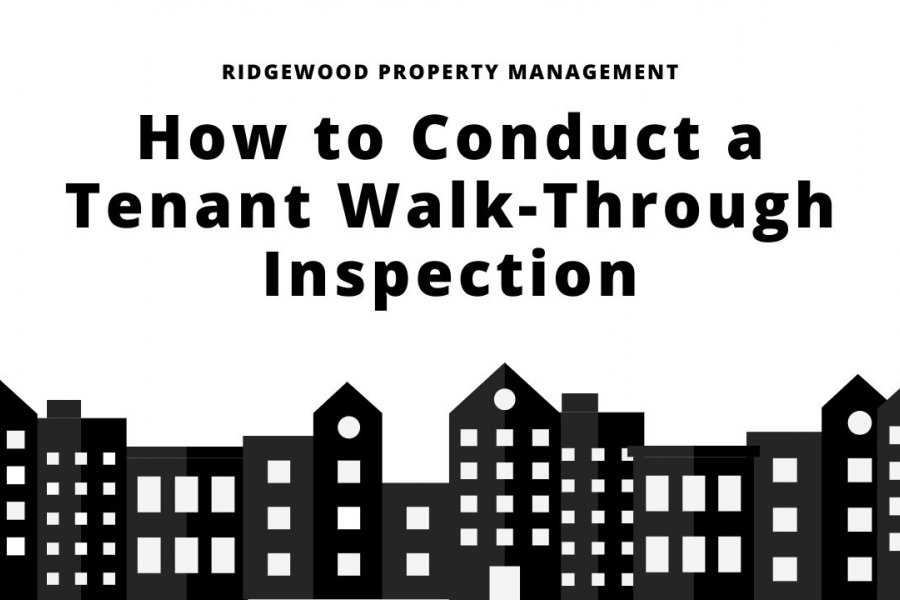
When renting out a property, the landlord and tenant have responsibilities to uphold. One crucial landlord responsibility is ensuring their rental property is in good condition before a tenant moves in. A walk-through inspection is a great way to document the condition of the property, identify any existing issues and address them before the tenant moves in.
Conducting a walk-through inspection can be challenging however, and some landlords might not know where to begin. Ridgewood Property Management will outline useful tips and guidelines for conducting a thorough walk-through inspection.
A thorough walk-through inspection with your tenants will help you create transparency, limit tenant disputes and protect your investment.
Create a Walk-Through Inspection Checklist
Creating a detailed walk-through inspection checklist is the first step to conducting a successful tenant walk-through. List all the items or areas of your property that need an inspection. Make sure your checklist covers every aspect of the property’s interior and exterior.
The checklist also needs to include a section noting any pre-existing damages or issues, including normal wear and tear. A well-designed checklist ensures nothing is overlooked and all issues are addressed. It also helps you avoid confusion during the inspection and ensures all parties involved are on the same page.
A comprehensive checklist is also beneficial in the case of any legal disputes that might arise between the landlord and tenant.
Document Your Property's Condition in Advance
Before a tenant moves in, it’s essential to document the property's condition. Documenting the property's condition beforehand ensures you have a clear record of its condition, which can be used as a baseline for comparison during the move-out walk-through inspection.

Taking pictures and videos of the rental property during the walk-through inspection is essential. This documentation can serve as proof of the property's condition and provide evidence of any issues or damages observed during the inspection.
Timestamping the pictures and videos can also establish the time and date of the property’s condition, which can serve as evidence in the event of a dispute. As a landlord, make sure to store any pictures and videos in a secure location for future reference.
Conduct the Walk-Through With Your Tenant
Conducting the walk-through inspection together with your tenant is crucial. It allows the landlord and tenant to inspect the property together and discuss any issues or concerns that come up. The tenant can also point out any areas that might have been missed, and the landlord can explain any potential problems that might arise during the tenancy.
Landlords who conduct the walk-through inspection with their tenant can better establish mutual understanding and trust. The inspection allows the landlord and the tenant to agree on the property's condition before the tenant moves in and limit future disagreements
Give the Tenant Time to Find Additional Issues
After the walk-through inspection, we suggest giving the tenant time to find any additional issues they might have missed during the inspection. This way, the tenant can bring up any concerns for you to address about the property's condition before they move in.

Giving the tenant time to find additional issues demonstrates the landlord's commitment to providing a safe and habitable rental property. It establishes a clear understanding between the landlord and tenant, ensuring both parties agree on the property's condition before the tenant moves in.
Do Your Own Checks
Before the tenant arrives for the walk-through inspection, we suggest the landlord do their own checks to make sure the property is ready for inspection. Double-check that all appliances are working correctly, the plumbing and electrical systems are functioning correctly and the doors and windows are secure.
You also need to check that any pre-existing damage or issues have been noted and that a plan is in place to address them.
Checking out the investment property beforehand helps you identify and address any issues before the tenant arrives. It also shows your commitment to providing a safe and habitable rental property, which will establish a good relationship with the tenant from the outset.
Understand Landlord-Tenant Laws in Your State
Before conducting a walk-through inspection, you need to be familiar with landlord-tenant laws in your state. These laws govern the landlord-tenant relationship and establish the rights and responsibilities of both parties. Familiarizing yourself with these laws ensures you comply with all regulations and avoid legal issues.

Landlord-tenant laws cover a wide range of issues including property maintenance, tenant screening, security deposits, eviction procedures and much more. Landlords should consult with a legal professional or property management company to ensure they understand the applicable laws and regulations.
Keep the Process Simple
Keeping the walk-through inspection process simple is crucial. A simple process ensures that all parties involved in the inspection can easily understand what is expected of them. A straightforward process can help avoid confusion, misunderstandings, and disagreements or lead legal disputes.
In a Nutshell: Tenant Walk-Through Inspections
Conducting a thorough walk-through inspection essential in rental property management. A good checklist can help landlords avoid disputes and ensure their investment property is well-maintained and successful.
By following the tips in this article, landlords can create a transparent process that benefits them and their tenants, which can lead to a positive landlord-tenant relationship.
Overall, conducting a thorough walk-through inspection is worth the time and effort for any landlord looking to maintain a profitable and efficient rental business.
Ridgewood Property Management can help property owners by providing professional and experienced property management services. We understand the importance of maintaining a good landlord-tenant relationship and can help ensure your property is well taken care of.
Contact us today at (800) 991-5968 to learn more about how we can help you manage your rental property.
